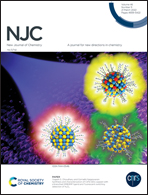Preparation and characterization of a series of high-energy and low-sensitivity composites with different desensitizers†
Abstract
A series of ultrafine CL-20 and HMX energetic composites with different insensitive agents (DOS, PVAc and PVB) were prepared using an electrostatic spray method. The results show that desensitizers have significant effects on the morphology and particle size, and composites have better packing density and better safety. FTIR and XRD analyses show the formation of co-crystals and the Raman test further confirmed their formation. The addition of insensitive agents has significant effects on the activation energy of the composites, and the addition of PVB makes the composites have greater activation energy and better thermal stability. The thermal decomposition models of CL-20 and HMX follow the D1 model. The thermochemical parameters indicate that the decomposition of the composite is advanced and the reaction speed is accelerated. Explosion performance parameter analysis shows that the composites have better mechanical properties. Besides, desensitizing agents have great effects on the safety performance of CL-20/HMX composites. Tighter hydrogen bonding interactions promote heat dissipation through non-radiative mechanisms, thereby limiting the generation of hot spots and improving the stability. Our studies may shed light on a new understanding of the design and synthesis of high-energetic and low-sensitive explosives.



 Please wait while we load your content...
Please wait while we load your content...